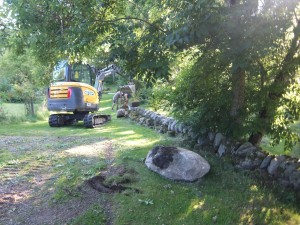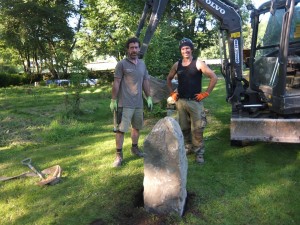
It’s that time of year, with the old and new on the move: combine harvesters and grain, clouds and kittens, diggers and stones. (The kittens come later; for now diggers and stones…)
This morning I posted an article from The Guardian on to my Facebook page. It’s about yet another discovery on the Salisbury Plain, famed for the iconic structure of Stonehenge but with our knowledge and understanding of prehistory being increasingly pushed ever further back into the mists of time: http://www.theguardian.com/uk-news/2015/sep/07/stonehenge-archaeology-ritual-arena-neolithic-monument
It seems that archeologists have discovered a massive new site dating back at least 4,500 years – a site far bigger and more extensive that any previously found. And that is saying something, because it is now accepted that Stonehenge itself is just a small part of a prehistoric culture of ritual practices that extends for miles all around…
It’s my interest in such ongoing discoveries that spurred me on to create a board on my Pinterest site under the title Pushing Back the Years, with the following lines as minimalist explanation: New discoveries are pushing back our understanding of pre-history all the time… at the same time ignorance, ego and development places investigation and discovery under threat. We have so much to learn if we choose to survive.
Having read the article, I laugh aloud, having just remembered that Euan and Jamie are coming today to manouevre various rocks into place in our garden. Yes, the practice of setting stones continues…
It began when friend Naomi in London announced that she wanted to come north to stay in order to talk to Akii about Japanese gardens. ‘Ha’, I replied. ‘Like so many Japanese, sadly he walks around them knowing little to nothing about the origins of their design…’
It seems she had just finished reading Tan Twan Eng’s novel ‘The Garden of Evenings Mists’ , which centres around a garden in Malaysia created by a Japanese diplomat (who may or may not have been an Imperial gardener) before the Pacific conflict. A must-read, she reckoned. So I did – bought and read it – and quickly found myself ordering a second book, one that is referred to over and over again throughout the 2012 winner of the Man Asian Literary Prize.
‘Sakuteiki – Visions of the Japanese Garden’ is the most recent translation of two ancient scrolls. Originally scribed in the 11th century, and in combination, they are not only the oldest surviving treatise on Japanese gardening but the oldest known book on gardening in the world.
Sakuteiki (lit. records of garden making) makes for fascinating reading, as the links between setting stones in Japanese gardens and in places and spaces in ancient times become so clear. I read the introductory chapters – if this is how they may be described – on Nature, Geomancy, Buddhism and Taboos, and then the records themselves: on different gardening styles, how to create streams, waterfalls, ponds and islands, plant trees and most interesting of all to me right now, how to set stones.
Work began a few weeks ago on what was (before her death in 2012) my aunt’s house and garden, and as diggers got to work, levelling ground and dismantling walls, I begged some of the boulders and lintels from the two men there working every day. Expert dykers, I was amazed at the speed with which they rebuilt walls and stairs to the new owners’ and architect’s design. And yes, they were perfectly happy to help, especially since I would be commemorating the building’s original function as quarry workers’ cottages and gardens.

One boulder, lying where dropped, decided to stay where it was, welcoming arrivals and showing off the view of the labyrinth below
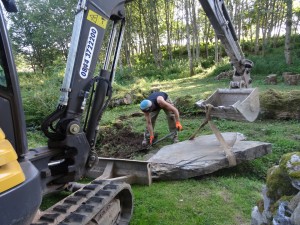
Jamie digs out the far bank so that a massive slab of granite can be positioned over the burn by Euan handling the digger
When they arrive – carrying two of the largest stones in diggers – I shall have my compass at the ready. Just as the Ancients set dolmens (standing stones) according to the four quadrants (north, south, east and west) and when grouped (more often than not) in alignment with the stars, so I shall do my best. I know for sure what not to do, according to the rules of fusui (better known in the west as the Chinese feng shui), but otherwise placement will basically be in the hands of Jamie, Euan and the gods…
But this feels comfortable enough. The origin of setting stones (ishi wo taten koto in Japanese) is traced to the use of prehistoric sites with naturally standing stones for prayer and ritual. Those with a rounded form and upright appearance were considered especially powerful.
As the Sakuteiki explains: It is believed that through the medium of the stone (and as believed in Japan’s animist religion, shinto), gods could be induced to descend from their heavenly abodes to visit earth and bestow their blessings or good health and ample harvests on village communities. These sacred stones, called iwakura, are still actively incorporated in religious life today. In later eras (after Buddhism was introduced into Japan from Korea via China in the 8th century), the spiritual qualities inherent in sacred stones carried over into the use of stones in gardens.
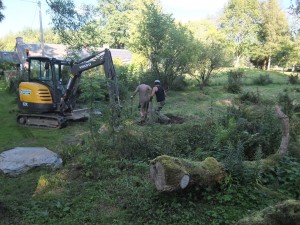
Euan and Jamie manhandle the first dolman into place at the entrance to the meadow. Flat sides facing north and south, it will sit two thirds above the surface
So here come Jamie and Euan, and I must get to work with not only that compass, but also my camera. All under the ever-watchful eyes of two new kittens who are just settling into their seventh week here. Sora (sky) and Hoshi (from shooting star) graduated this week to the genkan (lobby, in this case made of glass) and are fascinated by the general business of the garden – rabbits, deer, birds, mice… Today, however, they have (especially in cats years) a once-in a lifetime treat in store…
My aunt liked continuity. I believe she approves that some of the stones she so loved at Downalong have moved up the road to Burnside. She regards it as a further indication that we putting down roots. Roots that will last far longer than we will, but like Stonehenge and the many stone circles in Perthshire, will remain for time immemorial to remind us of the fleeting nature of human life.
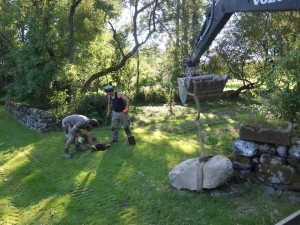
Digging out the hole for the last stone at the entrance to the labyrinth, equidistant between two ancient stone walls relaid five years ago by neighbour (and sadly now retired dyker) Paul Latham

